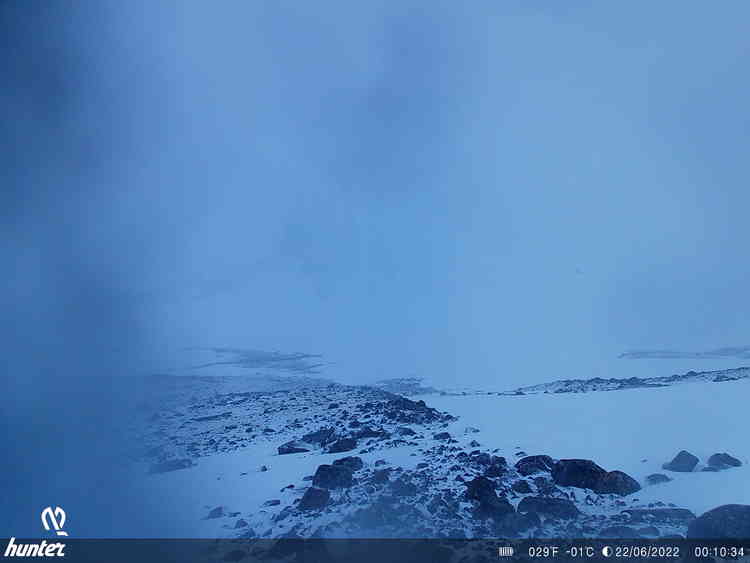Nina Kirchner, Annika Granebeck, Jamie Barnett, Daniella Lillieroth Charalambous
This dataset contains images of Lake Tarfala taken every 2 hours during the period from 22 June to 28 July 2022. During this period, the surface of Lake Tarfala transitions from being ice-covered to ice-free, an event referred to as "ice-off".
The dataset can be used to observe the ice-off event and to assign a date (or, rather, a time interval) to it. Knowledge of lake ice phenology, i.e. seasonal formation and loss of the lacustrine ice cover, is of importance since the timing of ice-off impacts lake processes such as stratification and vertical mixing.
The pictures were acquired using a camera positioned on the mountain flank along Lake Tarfala’s north-eastern shore, at 1220 m above sea level. In total, there are 444 images.
Download data

Scientific highlights
This dataset allows to assign a precise date to the ice-off event at Lake Tarfala in summer 2022. Defining ice-off as the first occasion after the ice-covered winter season on which the lake becomes completely ice-free and remains so for the rest of the summer, it was attained on 27 July 2022.
Precise knowledge of the ice-off date can be used to:
- Assist in understanding lake mixing processes.
- Better constrain numerical models computing ice-off.
- Provide a complement to ice-off dates derived from satellite imagery, which is notoriously difficult in polar alpine environments due to persistent cloud cover and long polar nights.
- Lend support to alternative definitions of ice-off.
- Contribute to knowledge of lake ice phenology in high altitude Arctic environments under current climate change.
Some notable events in the time-lapse imagery of the diminishing lake ice cover include:
- 24 June: Commence of ice cover melt in the north-western lake-corner where Kebnepakte Glacier drains into Lake Tarfala (right margin of picture, e.g. at 00:10).
- 1 – 7 July: Retreat of ice cover along eastern lake shoreline (foreground of picture, most visible on 7 July at 04:10) and increasing number of melt features on the central lake ice cover, mimicking surface meltwater ponds (most visible 6 July at 18:10).
- 8 July: Crack formations in the southern part of the lake ice cover (left margin of picture, e.g. at 22:10). Repeated occurrence of the phenomenon in the central parts of the ice surface on 15 July (at 04:10).
- 17 July: Onset of lakewide drift and disintegration of ice floes.
- 21 July: Inflow of sediment-rich streamwater from stream network on the eastern lake bank (left margin of picture, at 12:10 until 16:10). Repeated occurrence of the phenomenon can be seen on 27 July (at 06:10 until 12:10).
Note that the camera produces black-white images under certain light conditions, such as under some low-visibility weather conditions.
Citation
Nina Kirchner, Annika Granebeck, Jamie Barnett, Daniella Lillieroth Charalambous (2023) Time lapse imagery of the ice-off event at Lake Tarfala, Kebnekaise Mountains, northern Sweden, summer 2022. Dataset version 1. Bolin Centre Database. https://doi.org/10.17043/tarfala-kirchner-2023-ice-off-2022-1
Data description
The dataset consists of image files (JPG) of Lake Tarfala, with the date and time (Swedish daylight saving time, UTC+2) included in each photo.
The pictures were acquired using a camera positioned on the mountain flank along Lake Tarfala’s north-eastern shore, at ~67.9° N, 18.6° E, at 1220 m above sea level.
The data were collected using a Hunter Orion Trail Camera 4G. The camera elevation is 1.8 m above ground. Each JPG file has a size of ~2.4 MB. The total size of the dataset is ~927 MB.
In order to protect personal data in accordance with the EU General Data Protection Regulation (GDPR), small parts of four images have been concealed.
During a few short periods, fog, snow and/or rain obscures the view of the lake.
Comments
The support of our co-workers on the Arctic Avenue activity Lake thermal and mixing dynamics under changing climate (J. Weckström, K. Weckström, A. Korhola, and F. Schenk) is gratefully acknowledged.
